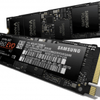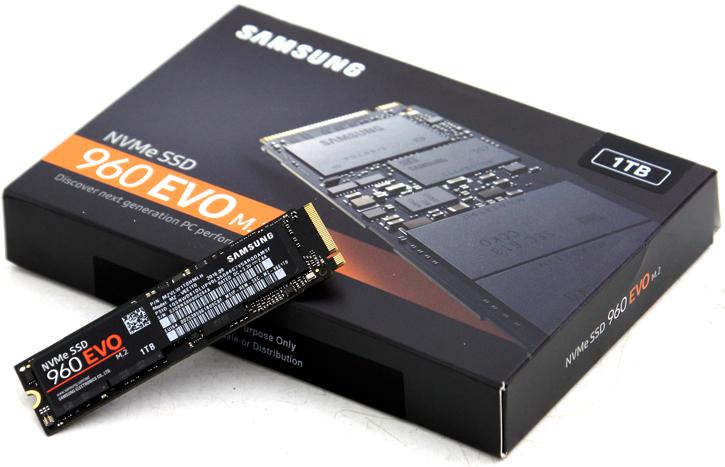Introduction
Samsung 960 EVO 1 Terabyte M.2 NVMe SSD
More value at with blazing performance
Precisely one month after the 960 Pro release Samsung releases the 960 EVO. The more wallet friendly M.2. SSD promises to be roughly as fast and versatile as the Pro model, a product once again based on a Polaris based controller. These new M.2 EVO and PRO units can now be purchased in volume sizes up-to 1 TB and use the latest iteration of the nvm express (NVME) 1.2 protocol which is even faster anno 2016. NVMe Storage technology is advancing with extremely fast paces and steps. And correct, you read that right as the EVO is based on a Samsung Polaris controller, not to be confused with anything from AMD, of course. The new 960 EVO has been fitted with 48-layer MLC 3-bit per cell (TLC written) NAND. Today we will focus on that new EVO model, we have received a 1TB model for testing. The product is only slightly slower compared to the PRO model and capable of sequential read performance of 3,200 MB/s and sequential write speeds of up to 1,900 MB/s. Alongside this 960 EVO release, Samsung now also also offers a dedicated Samsung NVMe Driver 2.0, for maximal compatibility and performance.
Samsung is to release the new 960 EVO model in capacities of 250 GB, 500 GB and 1 TB volume sizes. Performance wise you'll get a smile on your face, it these units are tagged with sequential transfer rates of over 3200 MB/s reads, with up to 1900 MB/s writes; up-to 380,000 IOPS 4K random-read, and up to 360,000 IOPS 4K random-write. The precise performance values differ per model / volume size though, we'll discuss and show you that on the next page. The 960 series is available in an M.2 (NGFF-2280) form factor. These units obviously will require PCI-Express 3.0 with x4 lanes as the SSDs are using the latest iteration of the NVMe protocol. The Samsung 960 EVO still offers plenty of endurance, depending on volume site 400 Terabytes written (TBW), for the 1 TB capacity, half that for the 500 GB version and again half of that for the 250 GB model. The EVO series will receive a three year warranty. These new M.2 units use the NVMe protocol and that means storage technology at hyper fast speeds while remaining competitive in pricing. The 1024 GB model we test today is capable of passing that 3GB/s marker for reads and close to 2000 MB/second sequential on writes. The Samsung 960 EVO SSD is Samsung’s last generation consumer-ready Non-Volatile Memory Express (NVMe) M.2 form factor SSD with vertical NAND (V-NAND) technology (48 layers/128 Gb & stacked). Storage technology keeps advancing at the fast pace it does, the performance numbers a good SSD offers these days are simply excellent as you can reach say 450 MB/s to 500 MB/sec on SATA3 which is the norm for a single controller based SSD. Next to that, over the past year, NAND flash memory (the storage memory used inside an SSD) has become much cheaper as well.
| Drive | Seq Read | Seq Write | ddr3-cache | Endurance in TBW | Price |
|---|---|---|---|---|---|
| 960 EVO 250GB | 3200MB/s | 1500MB/s | 512MB | 100TB | 129 usd |
| 960 EVO 500GB | 3200MB/s | 1800MB/s | 512MB | 200TB | 249 usd |
| 960 EVO 1TB | 3200MB/s | 1900MB/s | 1GB | 400TB | 479 usd |
| 960 Pro 512GB | 3500MB/s | 2100MB/s | 512MB | 400TB | 329 usd |
| 960 Pro 1TB | 3500MB/s | 2100MB/s | 1GB | 800TB | 629 usd |
| 960 Pro 2TB | 3500MB/s | 2100MB/s | 2GB | 1200TB | 1299 usd |
Samsung’s new 960 EVO/PRO M.2 product line is powered by the company’s new Polaris controller, which we think might be based of the older UBX one. The unit follows a smaller M.2 2280 form factor so it will fit on most ATX motherboards capable of M.2 just fine (or just use a PCI-Express daughter card but make sure you have x4 Gen 3.0 lanes available for it). IOPS numbers are now passing the 300K for read and writes marker (depends on volume size). At just one-tenth the weight of a traditional 2.5-inch SSD, the M.2 SSDs are ideal for users looking to upgrade their desktop or ultra-thin PCs with high-capacity, high-performance storage. Usability and compatibility then - remember, you do need a modern motherboard with capable NVMe supported M.2 (PCIe x4 connected) interface though, please do check out your motherboard manufacturer for that. But ever since Z97/Z170 and most last gen X99 chipsets have been released, the mainstream to high-end class motherboards almost all support the M.2. interface with NVMe protocol.
Yeah, have a peek, and then let's head on-wards into this review.


